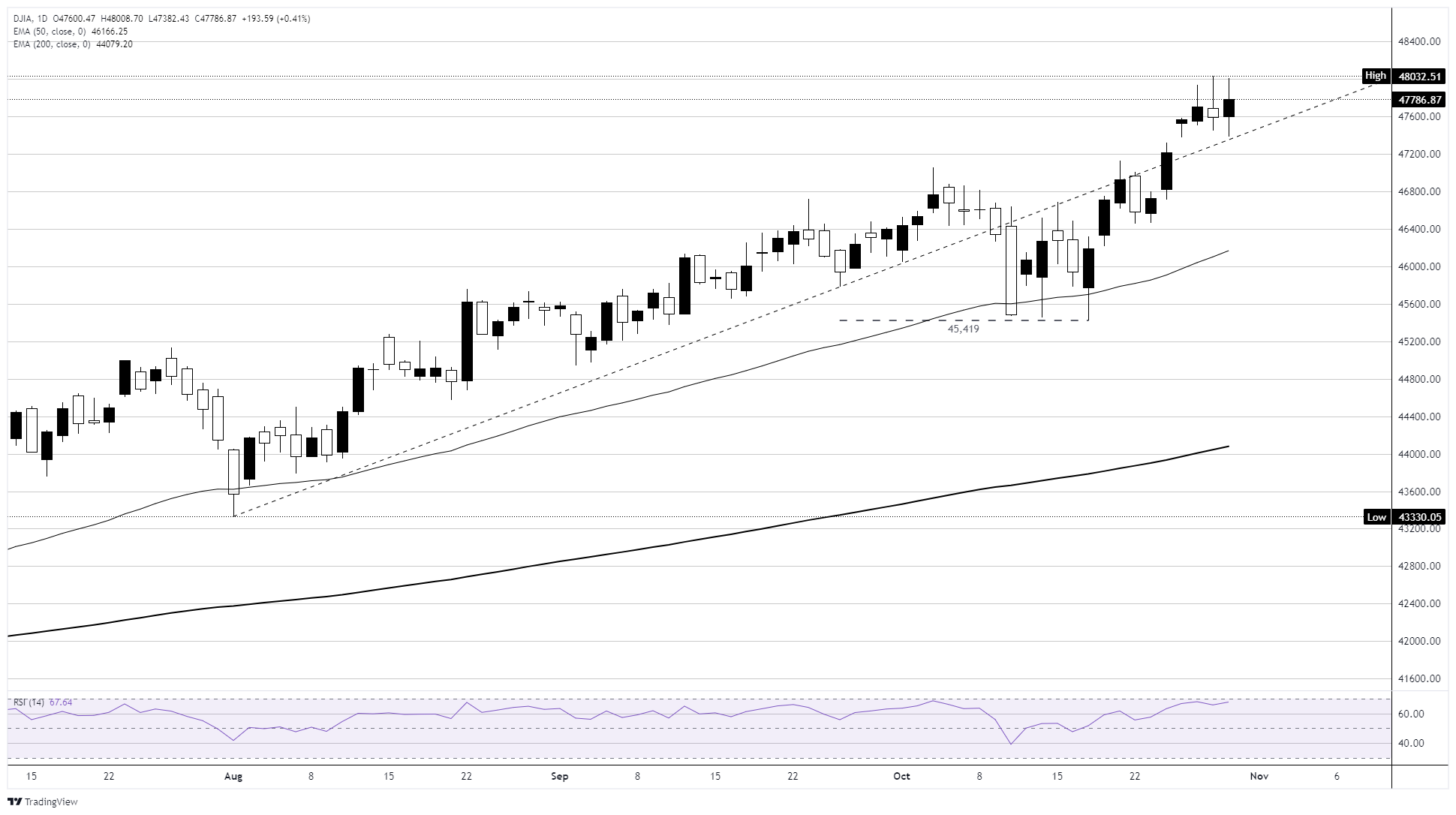Dow Jones Industrial Average steadies as markets digest Fed stance
- The Dow Jones holds steady near record highs after the Fed’s rate cut this week.
- Investors have grown cautious, trimming their bullish momentum after a vigilant Fed showing.
- Odds of a third straight rate trim in December have declined significantly; focus shifts to January.
The Dow Jones Industrial Average (DJIA) held in place on Thursday, churning chart paper near record highs as investors reconsidered their stance following the Federal Reserve’s (Fed) latest appearance. The Fed delivered a second straight quarter-point interest rate cut this week, as many broadly expected. However, a decidedly cautious appearance from Fed Chair Jerome Powell has dashed market hopes for a threepeat rate cut in December onto the rocks.
As noted by Fed Chair Powell during Wednesday’s post-rate-cut press conference, the still-ongoing US federal government shutdown has dried up the flow of official data sources, specifically key inflation metrics and critical monthly labor data. Lacking the two main information streams that allow the Fed to perform its dual functions of controlling inflation and supporting employment, Fed Chair Powell warned that Fed policymakers may be forced back into a wait-and-see stance until official numbers can resume regular reporting.
Threepeat rate cut when?
With the Fed facing an inability to monitor the economy, market bets of a third consecutive rate cut on December 10 have faltered, with rate traders placing a much higher emphasis on the Fed’s first policy meeting in 2026 for a third rate trim. If the Fed misses December’s rate cut opportunity, investors will be hoping for a follow-up rate cut on January 28, with a few particularly begrudging rate betters seeing a third cut in March of next year.
Dow Jones daily chart

Dow Jones FAQs
The Dow Jones Industrial Average, one of the oldest stock market indices in the world, is compiled of the 30 most traded stocks in the US. The index is price-weighted rather than weighted by capitalization. It is calculated by summing the prices of the constituent stocks and dividing them by a factor, currently 0.152. The index was founded by Charles Dow, who also founded the Wall Street Journal. In later years it has been criticized for not being broadly representative enough because it only tracks 30 conglomerates, unlike broader indices such as the S&P 500.
Many different factors drive the Dow Jones Industrial Average (DJIA). The aggregate performance of the component companies revealed in quarterly company earnings reports is the main one. US and global macroeconomic data also contributes as it impacts on investor sentiment. The level of interest rates, set by the Federal Reserve (Fed), also influences the DJIA as it affects the cost of credit, on which many corporations are heavily reliant. Therefore, inflation can be a major driver as well as other metrics which impact the Fed decisions.
Dow Theory is a method for identifying the primary trend of the stock market developed by Charles Dow. A key step is to compare the direction of the Dow Jones Industrial Average (DJIA) and the Dow Jones Transportation Average (DJTA) and only follow trends where both are moving in the same direction. Volume is a confirmatory criteria. The theory uses elements of peak and trough analysis. Dow’s theory posits three trend phases: accumulation, when smart money starts buying or selling; public participation, when the wider public joins in; and distribution, when the smart money exits.
There are a number of ways to trade the DJIA. One is to use ETFs which allow investors to trade the DJIA as a single security, rather than having to buy shares in all 30 constituent companies. A leading example is the SPDR Dow Jones Industrial Average ETF (DIA). DJIA futures contracts enable traders to speculate on the future value of the index and Options provide the right, but not the obligation, to buy or sell the index at a predetermined price in the future. Mutual funds enable investors to buy a share of a diversified portfolio of DJIA stocks thus providing exposure to the overall index.

